Campus Crusade Leaders Searching
Before we look at Saint Ignatius himself, let’s tell this story.
About fifty years ago some Campus Crusade leaders were filling Big Ten university stadiums with great crowds of young people, converting them to Jesus Christ. I heard some of these dynamic men speak after they became Orthodox. It must have been exciting.
They hoped they were changing the 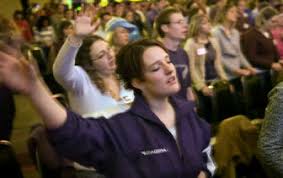 lives of these students for the better. But then… not long afterwards they discovered that almost all their new converts had gone back to “normal” life as if nothing had ever happened. These Campus Crusade men determined to find out why. They turned to the Scriptures and realized that in the New Testament there was “Church” to follow up and nurture new Christians.
lives of these students for the better. But then… not long afterwards they discovered that almost all their new converts had gone back to “normal” life as if nothing had ever happened. These Campus Crusade men determined to find out why. They turned to the Scriptures and realized that in the New Testament there was “Church” to follow up and nurture new Christians.
So they quit Campus Crusade and went home and, in the modern Evangelical way, founded churches based on New Testament principles. After a while they got together again and discovered that none of their churches were alike. They all had very different ideas about what the New Testament taught. They concluded that “Bible alone” was not a sufficient foundation.
So they decided that in order to understand how the very early Christians had understood the New Testament, they needed to know what the early post-New Testament Church was like. (They all were seminary graduates. Orthodox readers may find it hard to believe, but most modern Protestant seminaries teach little or nothing about the Church Fathers – or much of anything else about Christian history till the Protestant Reformation.) They agreed that whatever they discovered they would follow. These admirable men were genuine Christian seekers after truth.
Each took one aspect of the early Church to research. When they gathered to hear what they had  found, they were utterly shocked. One of them read the letters of Saint Ignatius of Antioch and reported: Bad news, brothers. Before the end of the First Century, Saint Ignatius was second Bishop of Antioch, in direct succession from the Apostle Peter who had founded that Church. Even “worse”, Ignatius taught that the Holy Eucharist is the true “Flesh” of Christ – and much more. All this from a man who certainly had known the Apostles Peter and Paul personally in Antioch.
found, they were utterly shocked. One of them read the letters of Saint Ignatius of Antioch and reported: Bad news, brothers. Before the end of the First Century, Saint Ignatius was second Bishop of Antioch, in direct succession from the Apostle Peter who had founded that Church. Even “worse”, Ignatius taught that the Holy Eucharist is the true “Flesh” of Christ – and much more. All this from a man who certainly had known the Apostles Peter and Paul personally in Antioch.
What they discovered in Saint Ignatius was confirmed and elaborated by the rest of their research. For example, in the early Second Century the Philosopher Justin the Martyr of Rome wrote that, in accordance with the tradition handed down to them, the Sunday worship of the Church was the Holy Eucharist, following liturgical forms.
All this meant that these former Campus Crusade leaders had been almost entirely wrong about Church and worship and so much more. Nevertheless they bravely continued their quest. It’s a long story – but, as you may know, in 1987 they and about 2000 former Evangelicals with them were received by 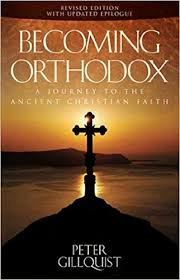 Antiochian Metropolitan Philip of North America into the Orthodox Church. They inspired many others to follow them. Most of these blessed men have now departed this earth, safely cradled in the arms of our Lord Jesus Christ and his Holy Church. Thank God. Thank Saint Ignatius.
Antiochian Metropolitan Philip of North America into the Orthodox Church. They inspired many others to follow them. Most of these blessed men have now departed this earth, safely cradled in the arms of our Lord Jesus Christ and his Holy Church. Thank God. Thank Saint Ignatius.
You can find the full account of this story in Father Peter Gillquist’s book Becoming Orthodox.
Saint Ignatius of Antioch
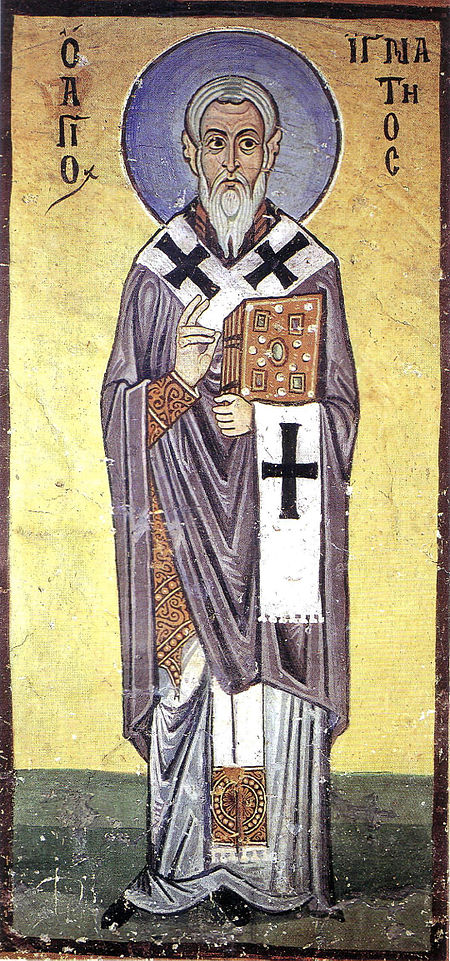 We know nothing for sure about his early life. A tradition says he was the boy in Matthew 18 whom the Lord Jesus took in his arms and blessed. Bishop Ignatius is said to have originated antiphonal singing – music sung alternating from one side to the other across the church. We do know that during his lifetime he was already nicknamed Theophoros, o Θεοφόρος, the God-bearer. His people must have found God’s presence radiating from him.
We know nothing for sure about his early life. A tradition says he was the boy in Matthew 18 whom the Lord Jesus took in his arms and blessed. Bishop Ignatius is said to have originated antiphonal singing – music sung alternating from one side to the other across the church. We do know that during his lifetime he was already nicknamed Theophoros, o Θεοφόρος, the God-bearer. His people must have found God’s presence radiating from him.
What we know for certain about him comes only from the last months of his life. About the year 106 Emperor Trajan had just won a victory and, being in a triumphal mood as he passed through Antioch, called all to join him in giving thanks to the gods. Christians refused. So, to make an Empirewide example of them, he had their Bishop Ignatius arrested and sentenced to be thrown to the wild beasts in the arena in Rome. At this time Saint Ignatius was about 84 years old. He was prepared to die for his Lord and Master.
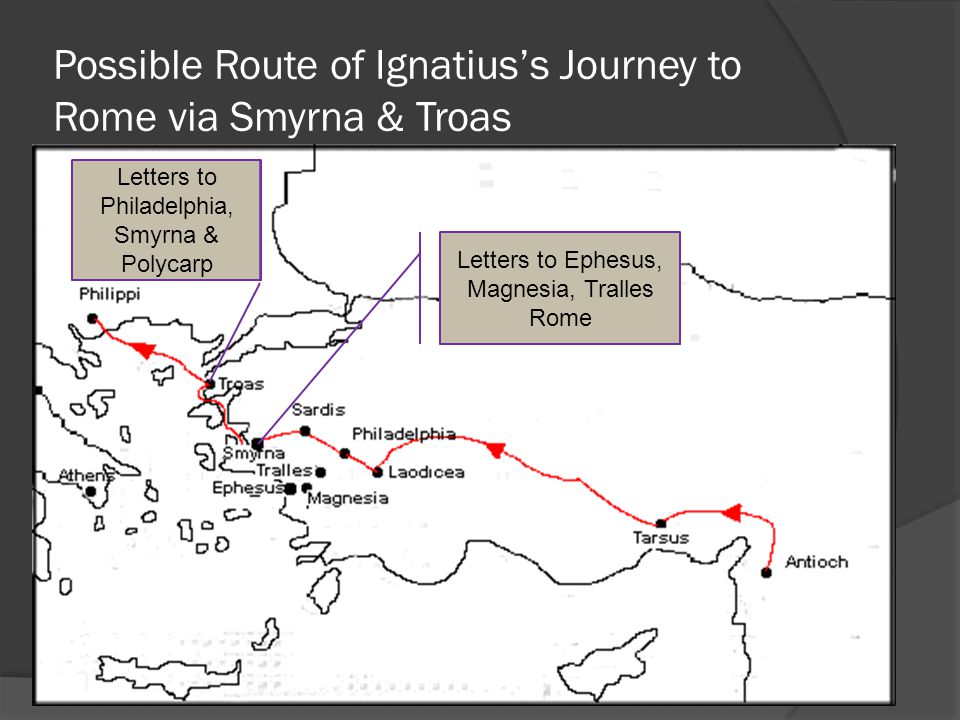 He was sent west, under guard. Since he was well known among Christians, along the way people came out in numbers from the many churches to see the holy Bishop. Sometimes he was allowed to meet with their leaders. He also wrote letters to some of the churches, the Epistles of Saint Ignatius which give us a vivid picture of life in the very early Church.
He was sent west, under guard. Since he was well known among Christians, along the way people came out in numbers from the many churches to see the holy Bishop. Sometimes he was allowed to meet with their leaders. He also wrote letters to some of the churches, the Epistles of Saint Ignatius which give us a vivid picture of life in the very early Church.
The trip was difficult. He wrote to the Church in Rome: “I fight with wild beasts by land and sea, by night and day, being bound amidst ten leopards, this company of soldiers, who when I treat them kindly only grow worse.”
Christians are urged to make every effort to escape persecution. But Bishop Ignatius knew he would die soon in any event, so he saw martyrdom as the crown of his long life, his final and most sure witness to Christ. So he wrote to the Christians in Rome begging  them: “I plead with you, do not do me an unseasonable kindness. Let me be fodder for the wild beasts. Then I shall be a true disciple of Jesus Christ. I shall be set free, I shall rise to freedom… I would rather die and get to Jesus Christ, than reign over the ends of the earth. This is who I am looking for, the One who died for us. This is who I want, the One who rose for us. Do not stand in the way of my coming to life, do not give back to the world one who wants to be God’s. My Desire has been crucified and there burns in me no passion for material things. There is living water in me which speaks and says within me: Come to the Father.”
them: “I plead with you, do not do me an unseasonable kindness. Let me be fodder for the wild beasts. Then I shall be a true disciple of Jesus Christ. I shall be set free, I shall rise to freedom… I would rather die and get to Jesus Christ, than reign over the ends of the earth. This is who I am looking for, the One who died for us. This is who I want, the One who rose for us. Do not stand in the way of my coming to life, do not give back to the world one who wants to be God’s. My Desire has been crucified and there burns in me no passion for material things. There is living water in me which speaks and says within me: Come to the Father.”
Can anyone read this without our eyes filling with tears? Pray God that when the end of our earthly lives come, we can pray with him: “There is living water in me which speaks and says within me: Come to the Father.”

An account attributed to eyewitnesses (The Martyrdom of Ignatius) says that on December 20 (the reason for this Post today on his feast day) in about the year 107 Bishop Ignatius of Antioch was led into the arena in Rome. The lions were released and tore him to pieces. Some say the Emperor was so moved that he stopped the persecution for a while. His relics were taken home to Antioch, arriving on January 29. In the year 637 they were returned to Rome, probably to protect them from the Muslims, where to this day they lie in honor under the altar of San Clemente Church.
Saint Ignatius is naturally especially loved in the Patriarchate of Antioch, to which I belong. Here he is on our icon screen at Saint Nicholas Church, Cedarburg. 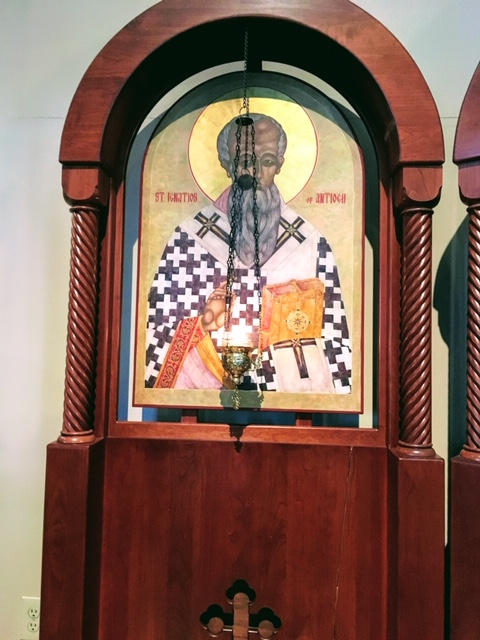
The Early Church in the Epistles of Saint Ignatius
Did I personally research all of the following? No! Parts of it, yes. Some I came across many years ago, I don’t know where. Some other information comes from New Advent, a Roman Catholic website – even though we Orthodox disagree with their conclusions regarding the Papacy, as we’ll explain below. In what follows “Smyrnaeans” etc. indicates “Epistle to the Smyrnaeans”.
Here are a few of the many things we can learn from Saint Ignatius:
1 The Authority of the Church’s New Testament
In his letters Ignatius quotes from at least the following books, as if they were already “normative” in his time:
Matthew John, Romans, 1 Corinthians, Galatians, Ephesians, Philippians, Colossians, 1 Thessalonians, 1 Timothy, 2 Timothy, James, 1 Peter, 1 John. We hear sometimes that “the New Testament didn’t exist” till the Canon of the Holy Scriptures was formally fixed at the Second Council of Trullo in 692. This is to misunderstand how these books became canonical – not because of a Council decision but because they already had been accepted by the Christian community, by the Church. Authentic Church Councils only reflect and affirm what the Church already believes.
Were the other New Testament books not accepted? Why did Saint Ignatius not quote from them? The obvious answers: He was not carrying a library with him! He was quoting from memory. Also he was using only passages that were particularly relevant to the points he was making.
2 The Truth of the Apostolic Faith: The Incarnation, the Virgin Birth, the Resurrection, the Church
“I glorify Jesus Christ, the God who has thus made you wise, for I observed that you are established in an immovable faith, as if nailed to the Cross of the Lord Jesus Christ, both in flesh and spirit, and firmly established in love by the blood of Christ, fully persuaded with regard to our Lord that he is truly of the family of David according to the flesh, Son of God with respect to the will and power of God, truly born of a Virgin, baptized by John, that all righteousness might be fulfilled by him, truly nailed [to the tree] for us in the flesh under Pontius Pilate and Herod the Tetrarch—from the fruit of which are we, from his divinely blessed Passion—that he might raise an ensign to the ages, through his Resurrection, for his saints and faithful, either among the Jews or the Gentiles, in the one body of his Church.” Smyrnaeans
of God with respect to the will and power of God, truly born of a Virgin, baptized by John, that all righteousness might be fulfilled by him, truly nailed [to the tree] for us in the flesh under Pontius Pilate and Herod the Tetrarch—from the fruit of which are we, from his divinely blessed Passion—that he might raise an ensign to the ages, through his Resurrection, for his saints and faithful, either among the Jews or the Gentiles, in the one body of his Church.” Smyrnaeans
This speaks for itself. All told in these Epistles Saint Ignatius spoke clearly of Christ’s divinity sixteen times, and of his Virgin Birth twice.
3 The Authority and Place of the local Bishop.
“See that you all follow the Bishop, even as Jesus Christ does the Father, and the presbytery [i.e. the Priests] as you would the Apostles; and reverence the Deacons, as being the institution of God. Let no man do anything connected with the Church without the Bishop. Let that be deemed a proper Eucharist, which is [administered] either by the Bishop, or by one to whom he has entrusted it. Wherever the Bishop shall appear, there let the multitude [of the people] also be; even as, wherever Jesus Christ is, there is the Catholic Church. It is not lawful without the Bishop either to baptize or to celebrate a love-feast; but whatever he shall approve of, that is also pleasing to God, so that everything that is done may be secure and valid.” Smyrnaeans
Does he mean absolute unquestioned obedience even to a bishop who has gone wrong? is heretical or a child abuser? Of course not. Elsewhere he exhorts people to “be deaf when anyone speaks apart from Jesus Christ” (Trallians), and “do not even listen to anyone unless they speak concerning Christ in truth”. (Ephesians) Saint Ignatius here must be addressing a situation where some people have been disobedient to a good faithful Bishop.
3 The Presence of Christ in the Holy Eucharist
Some followers of Jesus, then and now, have believed the Eucharist is only a meal to bring Jesus to mind. Here is what Saint Ignatius wrote:
“But consider those who are of a different opinion with respect 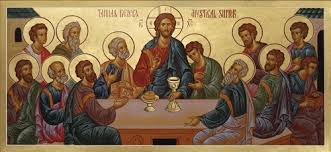 to the grace of Christ which has come to us, how opposed they are to the will of God… They abstain from the Eucharist and from prayer, because they confess not the Eucharist to be the flesh (σάρξ) of our Savior Jesus Christ, which suffered for our sins, and which the Father, of His goodness, raised up again.” Epistle to the Smyrnaens
to the grace of Christ which has come to us, how opposed they are to the will of God… They abstain from the Eucharist and from prayer, because they confess not the Eucharist to be the flesh (σάρξ) of our Savior Jesus Christ, which suffered for our sins, and which the Father, of His goodness, raised up again.” Epistle to the Smyrnaens
Bishop Ignatius also affirms here and elsewhere the bodily Resurrection of Christ, made present in the Holy Eucharist.
4 The “Locus” of the Catholic Church in its fullness
“Wherever Jesus Christ is, there is the Catholic Church.” Smyrnaens
To understand this, we need to free ourselves from the general Western understanding of the Church. This isn’t easy for us in the West. I’ll try to explain it as best I can grasp it.
According to Saint Ignatius, the Church is not primarily an organization spread geographically all over the world. The Church is an epiphany, the earthly manifestation of Jesus Christ in each place. As Father Schmemann said, “The Church is not an institution with sacraments. The Church is a Sacrament with institutions.”
The word “Catholic” derives from the Greek ὅλος which means “wholeness”. Saint Ignatius was saying “where Jesus Christ is present, there is the Church in all its fullness.”. So where is Jesus Christ? In the Church, his Body, “the place of His presence”. And in the Holy Eucharist, his Body, “the place of His presence”. Therefore where the Church is properly celebrating the Holy Eucharist, Jesus Christ cannot be any more present, any more fully and wholly “there”, than that. There is the Catholic Church manifested from heaven in each place.
 Indeed is that not how we all “experience” Jesus Christ and the Church – present in our local churches Sunday by Sunday, present in the Eucharist, present in the Church. And “Wherever Jesus Christ is, there is the Catholic Church.” The Catholic Church, the Church in its fullness is manifested at our Saint Nicholas Church in Cedarburg, Wisconsin, every Sunday morning. And at your church too.
Indeed is that not how we all “experience” Jesus Christ and the Church – present in our local churches Sunday by Sunday, present in the Eucharist, present in the Church. And “Wherever Jesus Christ is, there is the Catholic Church.” The Catholic Church, the Church in its fullness is manifested at our Saint Nicholas Church in Cedarburg, Wisconsin, every Sunday morning. And at your church too.
This is why in the letters of Saint Ignatius and in the Patristic view (and still in the Orthodox understanding today), the doctrine that to be Catholic people must be under the institutional authority of one particular Bishop just doesn’t make sense.
Conclusion
As you can tell, I’m finding it hard to stop. We’ve omitted so much more about the Church as it was then – and still is – and also so much truth, so much beauty, so much that is fascinating. Please read these Letters for yourself. You can easily find them online,
But if we must end, let’s do it with these beautiful passages, both addressed to the Church in Ephesus:
“Your Presbytery [council of Priests]… is a credit to God, is closely tied to the Bishop as the strings to a harp. Wherefore your accord and harmonious melody is a hymn to Jesus Christ. Yes, one and all you should form yourselves into a choir, so that in perfect harmony and taking your pitch from God, you may sing in unison and with one voice to the Father through Jesus Christ.”

“A star shone in heaven brighter than all the stars. Its light was indescribable and its novelty caused amazement. The rest of the stars, along with the sun and the moon, formed a ring around it; yet it outshone them all, and there was bewilderment whence this unique novelty had arisen. As a result all magic lost its power and all witchcraft ceased. Ignorance was done away with, and the ancient kingdom was utterly destroyed, for God was revealing himself as a Man, to bring newness of eternal life. What God had prepared was now beginning. Hence everything was in confusion as the destruction of death was being taken in hand.”
Next Week: The Meaning of Christmas. This will be a short Post, for a change!
Week after Next: Three? Magicians? Astrologers? Kings? the Star?

I’m pretty sure the 2000 were received into the Antiochian Orthodox Church in 1987.
And I’m pretty sure you’re absolutely correct, ma’am. Thank you! I confused it with the year our people at Saint Nicholas became Orthodox which was 1989. I’ll correct it immediately – so that anyone who reads our exchange here will have no idea what we’re talking about!
Here’s a video of the mass conversion. It’s wonderful, very moving!
https://youtu.be/o_2gI17e7A8
Too bad many of them brought non Orthodox baggage with them, that they retain to this day.
Since I came into Orthodoxy two years after most of the former Evangelicals, I’m sure the same thing can be said about me. New converts to anything tend to be overly enthusiastic. Looking back, I wish I had been like Saint Paul and kept my mouth shut for three years after I was converted. I feel I’m still in transition, and suspect it takes about 500 years to get truly into Orthodoxy! I hope you’ll correct me please when I betray too much of my Protestant/Anglican background.
Mariam, could you please tell us specifically what is the “non-Orthodox baggage…that they retain to this day”? They gave up all they had and humbly accepted Orthodoxy, so I’m sure they would value your critique.
I’ve noticed that this article about Saint Ignatius from last December is suddenly getting many “hits”. Can somebody tell me why? Just curious.